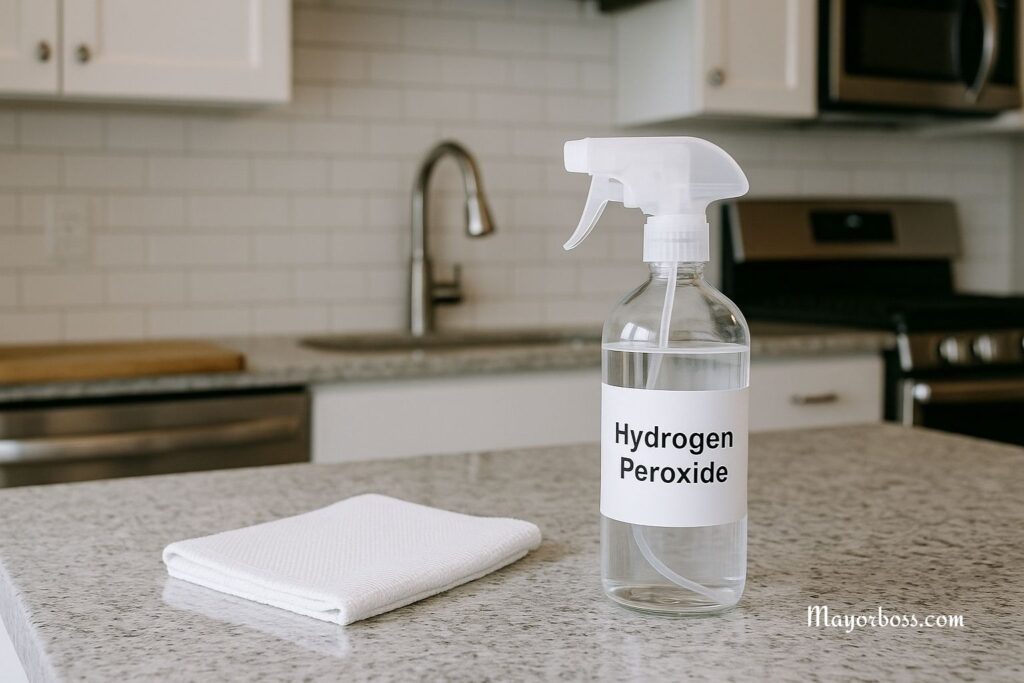You Can Clean Almost Every Surface in Your Kitchen With Hydrogen Peroxide
Hydrogen peroxide is one of the most overlooked cleaning agents you probably already have at home. This simple liquid is inexpensive, widely available, and safe when used correctly. It is a natural disinfectant, meaning it kills germs, bacteria, and even viruses. In fact, hospitals use it for cleaning because of its effectiveness. The good news is, you can use the same solution in your kitchen to keep surfaces fresh and hygienic.

Why Hydrogen Peroxide Works So Well
Hydrogen peroxide (usually sold as a 3% solution) works by releasing oxygen when it comes in contact with organic material. This bubbling action breaks down dirt, loosens debris, and kills harmful microorganisms. Unlike bleach, it leaves no strong odor and breaks down into water and oxygen, making it safer for the environment.
Cleaning Kitchen Counters
Your kitchen counters face daily exposure to food, spills, and germs. A quick spray of hydrogen peroxide can sanitize them effectively. After preparing raw meat or fish, it helps kill bacteria like Salmonella and E. coli that may linger on the surface. Spray it directly, let it sit for a few minutes, then wipe it clean with a damp cloth.
Freshening Cutting Boards
Cutting boards harbor bacteria deep in small grooves. After washing with soap and water, spray hydrogen peroxide onto the board and allow it to foam for a few minutes. Rinse with warm water. This method works for both plastic and wooden cutting boards. For extra cleaning power, you can alternate between hydrogen peroxide and white vinegar.
Disinfecting the Sink
The kitchen sink is often dirtier than the toilet seat. Hydrogen peroxide can disinfect it without harsh chemicals. Pour some directly into the sink, let it bubble for about 10 minutes, then scrub with a sponge and rinse thoroughly. It will leave the sink looking brighter while killing germs.
Cleaning the Refrigerator
Spills in the fridge not only cause odors but also create a breeding ground for bacteria. Use hydrogen peroxide on shelves, drawers, and handles. Spray, let it sit, then wipe clean. Unlike many chemical cleaners, it won’t leave behind harmful residue that could contaminate your food.
Stovetops and Ovens
Food splatters on stovetops and oven walls are tough to remove. Hydrogen peroxide softens grease, especially when combined with baking soda. Sprinkle baking soda over greasy areas, spray hydrogen peroxide, and let it foam. After a few minutes, scrub gently. This method avoids harsh oven cleaners, which often release strong fumes.
Cleaning Appliances
From microwaves to dishwashers, hydrogen peroxide can sanitize inside and outside surfaces. For the microwave, spray hydrogen peroxide on the walls, let it sit, and wipe away food splatters. For the dishwasher, spray around the door seals to prevent mold and bacteria buildup.
Sanitizing Sponges and Dishcloths
Sponges and dishcloths are notorious for harboring bacteria. To disinfect them, soak in a bowl filled with hydrogen peroxide for about 10 minutes. Rinse well before using again. This simple step prevents germs from spreading back onto your dishes and counters.
Whitening Grout and Tiles
Kitchen grout often becomes stained over time. Hydrogen peroxide acts as a mild bleaching agent. Apply directly to grout lines and scrub with an old toothbrush. For stubborn stains, make a paste with hydrogen peroxide and baking soda, apply it, and let it sit before scrubbing.
Deodorizing the Trash Can
Even after emptying, kitchen trash cans can hold onto unpleasant smells. Spray hydrogen peroxide inside the can and let it dry. This not only kills odor-causing bacteria but also keeps the can fresher between washes.
Important Safety Tips
- Always store hydrogen peroxide in its original dark bottle, as light breaks it down.
- Use the common 3% solution for household cleaning. Stronger concentrations can be unsafe.
- Test on small hidden spots first, especially for delicate surfaces, to avoid discoloration.
- Never mix hydrogen peroxide with vinegar in the same container—it can form peracetic acid, which is irritating to the skin and lungs.
Final Thoughts
Hydrogen peroxide is more than a first-aid staple. In your kitchen, it works as a powerful, eco-friendly cleaner that can handle nearly every surface. It sanitizes counters, freshens cutting boards, disinfects sinks, and even tackles tough grease. With proper use, this simple liquid can replace many commercial cleaners, giving you a safer and healthier kitchen.
FAQs
1. Can hydrogen peroxide replace bleach in the kitchen?
Yes. It disinfects surfaces without the harsh smell or toxic residue of bleach.
2. Is hydrogen peroxide safe for granite countertops?
It’s best to avoid using it on natural stone like granite or marble, as it may cause discoloration.
3. Can I use hydrogen peroxide to clean fruits and vegetables?
Yes, but rinse thoroughly with clean water afterward.
4. How often should I disinfect my kitchen sink with hydrogen peroxide?
At least once a week, or more often if you prepare raw meat or fish.
5. Does hydrogen peroxide expire?
Yes. Once opened, it loses strength over time. Replace bottles every 6 to 12 months.






